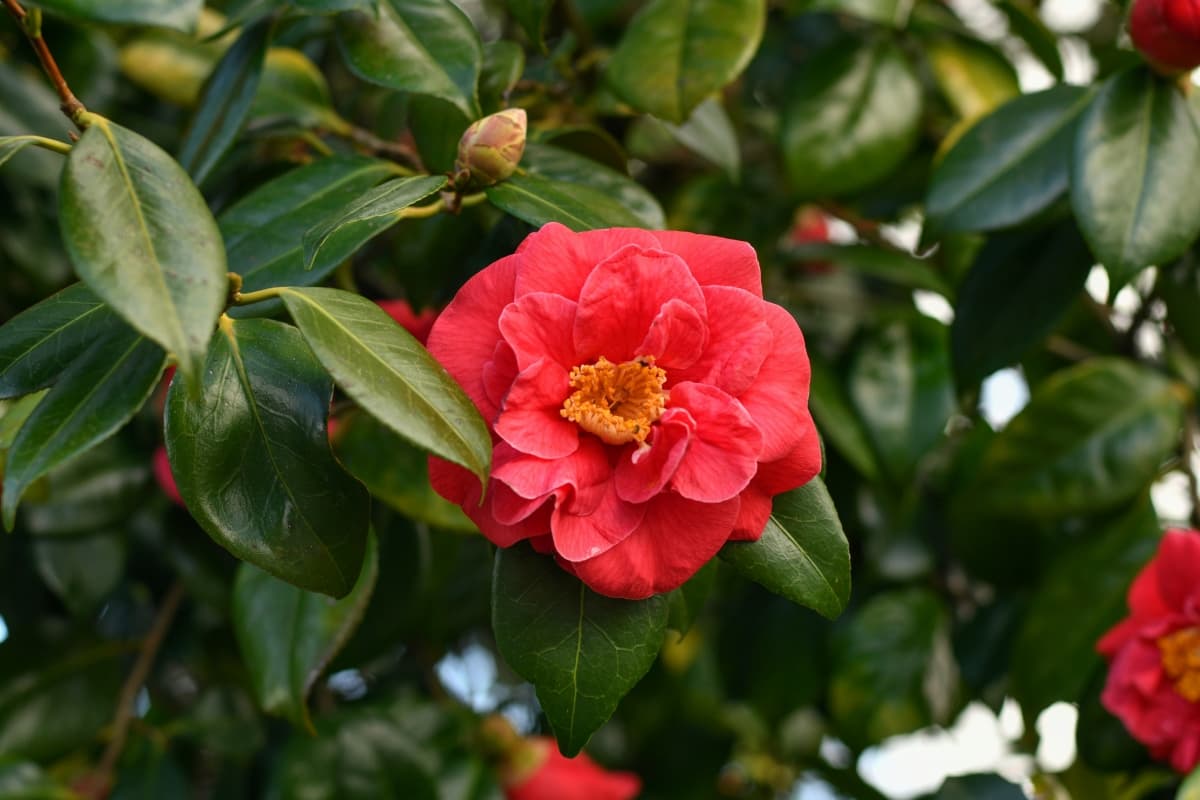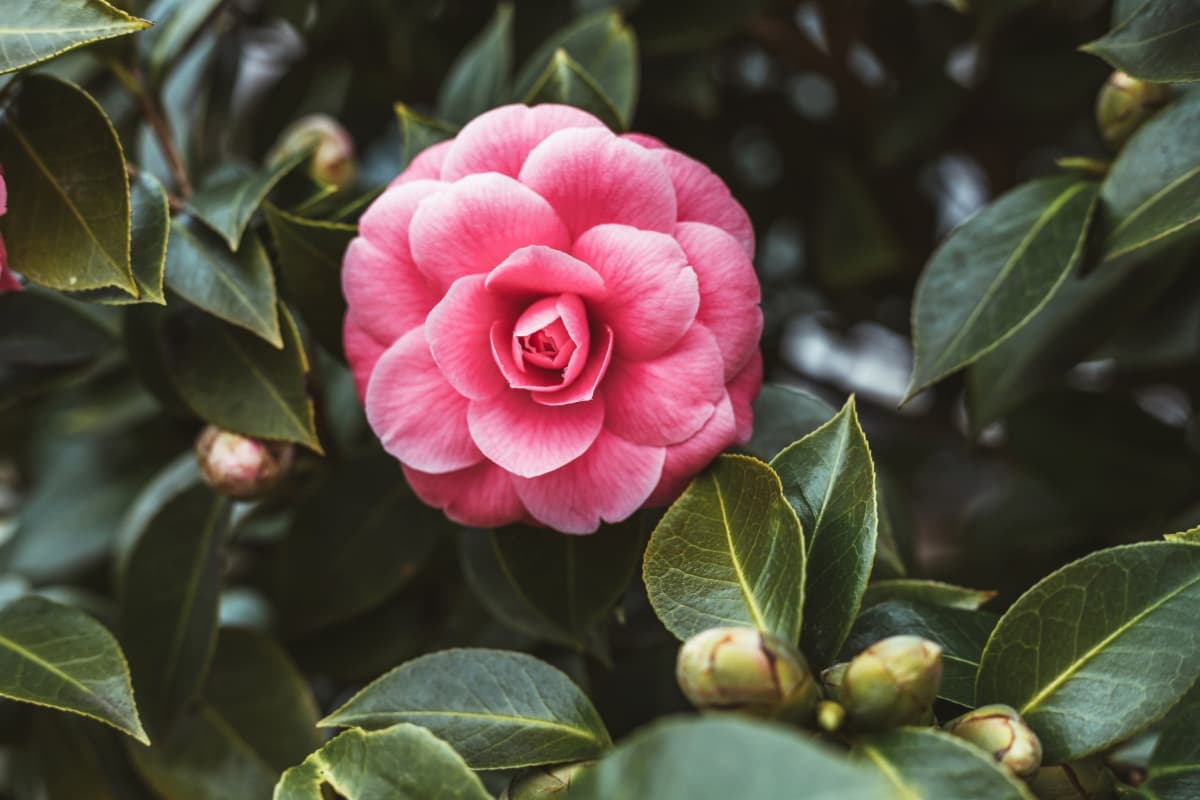Camellia plant is a genus of flowering plants in the family belonging to Theaceae. These stunning flowering plants are known for their vibrant blooms and glossy green foliage, making them popular among gardeners.

How to Grow and Care for Camellias in Containers/Pots
Best Soil for Growing Camellias in Containers
Choosing the right soil is crucial for growing Camellias in containers. Camellias thrive best in acidic soils with a pH range between 5.0-6.5. A potting mix rich in organic matter is ideal for container-grown Camellias.
Optimal Sunlight Requirements for Container Camellias
- Choose a place that receives several hours of morning sun followed by afternoon shade to provide light for your container Camellia. This will give your plant enough light without exposing it to too much direct heat.
- If you live in an area with hot summers or intense sunshine, consider providing additional shade during the hottest parts of the day. You can use sheer curtains or lightweight fabric covers to protect your plants from harsh rays.
Container Size and Selection for Camellias
- The container size and Camellias’ selection are crucial factors in the plant’s growth. Choosing the right container size will ensure your Camellia has enough room to grow and develop healthy roots.
- When selecting a container for your Camellia, a good rule of thumb is to choose one three to four inches larger than its existing root system’s width and depth. This will give your plant enough space to spread its roots without being too cramped or restricted.
- It’s essential to select containers with drainage holes at the bottom, which allow excess water to drain away from the soil.
Watering Tips for Camellias in Pots
- Watering is one of the most crucial aspects of growing Camellias in pots. When watering your Camellias, you need to strike a balance between providing enough water and avoiding overwatering.
- The frequency and amount of water required for your potted Camellias depend on various factors, such as the size of the container, humidity levels, temperature, and sunlight exposure.
- Another important factor when watering Camellias in pots is drainage. Poor drainage can cause excess moisture buildup around roots leading them to rot. Therefore, ensure proper drainage holes at the bottom of your pot so that excess water flows out freely.
Choosing the Right Fertilizer for Container-grown Camellias
- Camellias require a balanced fertilizer rich in nitrogen, phosphorus, and potassium. However, using too many nutrients can cause more harm than good.
- When selecting a fertilizer for your Camellia plant, look for one with an N-P-K ratio of 2:1:1 or 3:1:2. These ratios will provide the necessary nutrients without causing excessive foliage growth at the expense of blooms. When choosing a fertilizer, it’s also important to consider the soil you use in your container garden. If you’re growing your Camellias in acidic soil, choose a fertilizer for acid-loving plants.
Pruning Techniques for Camellias in Containers
Pruning is essential to Camellia care, especially for those grown in containers. It helps to promote healthy growth and encourages blooming. It is best to prune your Camellias right after they finish flowering, which can vary depending on the cultivar. When pruning your container-grown Camellias, removing any dead or damaged branches first is important. Then, you can shape the plant as desired by cutting back lateral shoots to just above a leaf node.
In case you missed it: How to Grow and Care for Butternut Squash: A Comprehensive Guide for Beginners

Be careful not to cut into old wood when pruning your Camellias, as this can cause damage that may take years to heal. Instead, focus on removing new growth from the previous season. If you want more blooms from your Camellias in pots, consider pinching off the tips of new growth during early spring or summer. This will encourage bushier plant growth and more flowers next season.
Protecting Camellias from Pests and Diseases in Pots
- Camellias are susceptible to various pests and diseases; protecting them from these problems is essential. One common pest that affects Camellias is mites, which can cause leaf damage and defoliation. To prevent this problem, you should regularly inspect your plants for signs of mite infestations.
- Another pest that can be a nuisance for Camellias in pots is aphids. These tiny insects suck sap from the plant leaves and stem, causing yellowing and distortion. You can control aphids by spraying your plants with insecticidal soap or neem oil.
- Fungal diseases can also harm container Camellias. Overwatering or poor drainage often causes root rot, while leaf spots are caused by fungi that thrive in moist conditions. To avoid these problems, ensure adequate drainage for your container-grown Camellias.
- Protecting container-grown Camellias from pests and diseases requires vigilance on the part of gardeners. Following cultural practices like providing adequate sunlight, water, and nutrients while ensuring good air circulation around the plant will help keep them healthy so they can thrive beautifully in their containers.
Winter Care for Camellias in Containers
- These plants are more susceptible to cold damage than their counterparts planted in the ground. The first step is to move your containerized Camellia plant away from areas where it may be exposed to freezing winds or temperature fluctuations. Choose a sheltered location that receives adequate sunlight during the day, such as a garage or porch.
- It’s important not to overwater your Camellia during winter as this can cause fungal diseases. Water the Camellia plant only when the soil feels dry an inch below the surface.
- Another crucial aspect of winter care for container-grown Camellias is protection against pests and diseases. Check regularly for signs of insect infestation or fungal growth on leaves and stems and take appropriate action if necessary.
- Mulching around the base of the plant using materials such as pine needles, straw, or shredded bark can also help insulate roots from extreme temperatures while retaining moisture levels within acceptable limits.
Transplanting Camellias from Pots to Larger Containers
- As your Camellia grows, it will inevitably outgrow its container. When this happens, transplant it into a larger container to give the roots more space and nutrients.
- Choose a new pot two or three sizes larger than the current one.
- Next, prepare some fresh soil mix with equal amounts of peat moss and perlite or vermiculite. You can also add some slow-release fertilizer pellets if desired. Gently remove the Camellia from its current pot by tipping it over and tapping on the sides until it slides out. Be careful not to damage any of the roots as you do this.
- Once removed from its current pot, loosen up any tangled roots around the surface of the root ball with your fingers or a forked tool. Place some soil in the bottom of your new pot, and then carefully place your Camellia in position. Fill around it with additional soil until level with where you want your plant’s base.
- Water thoroughly after planting but avoid fertilizing for at least 6 weeks since newly transplanted plants may suffer shock due to fertilization stress while their roots reestablish themselves in their new environment.
Tips for Promoting Blooming in Potted Camellias
- One of the best ways to encourage blooming is by providing adequate sunlight and fertilization during the growing season.
- You should also ensure that your Camellia has access to plenty of water throughout the year.
- Another tip is to monitor pests and diseases that could affect your plant’s health or prevent blooming.
- Regular pruning can help remove dead or damaged branches and stimulate new growth, producing more flowers.
In case you missed it: How to Grow and Care for a Christmas Cactus Houseplant: Instructions for Beginners

Conclusion
Growing and caring for Camellias in containers can be a rewarding experience for gardeners who love these beautiful flowering plants. With the right growing conditions, you can successfully cultivate your potted Camellia garden that will thrive year after year.
- Feed Your Flock for Less: Top 10 Tips to Save on Chicken Feed
- Ultimate Guide to Ossabaw Island Hog: Breeding, Raising, Diet, and Care
- Hatching Answers: The Top 10 Reasons Your Chickens Aren’t Laying Eggs
- Eggs and Economics: Breaking Down the Cost of Raising Backyard Chickens
- Defend Your Greens: Proven Methods to Keep Iguanas Out of Your Garden
- Ultimate Guide to Cinnamon Queen Chicken: A Comprehensive Guide for Beginners
- Ultimate Guide to California Tan Chicken: Breeding, Raising, Diet, Egg-Production and Care
- Ultimate Guide to Marsh Daisy Chicken: Breeding, Raising, Diet, and Care
- 10 Types of Chicken Farming Businesses You Can Start for Profits